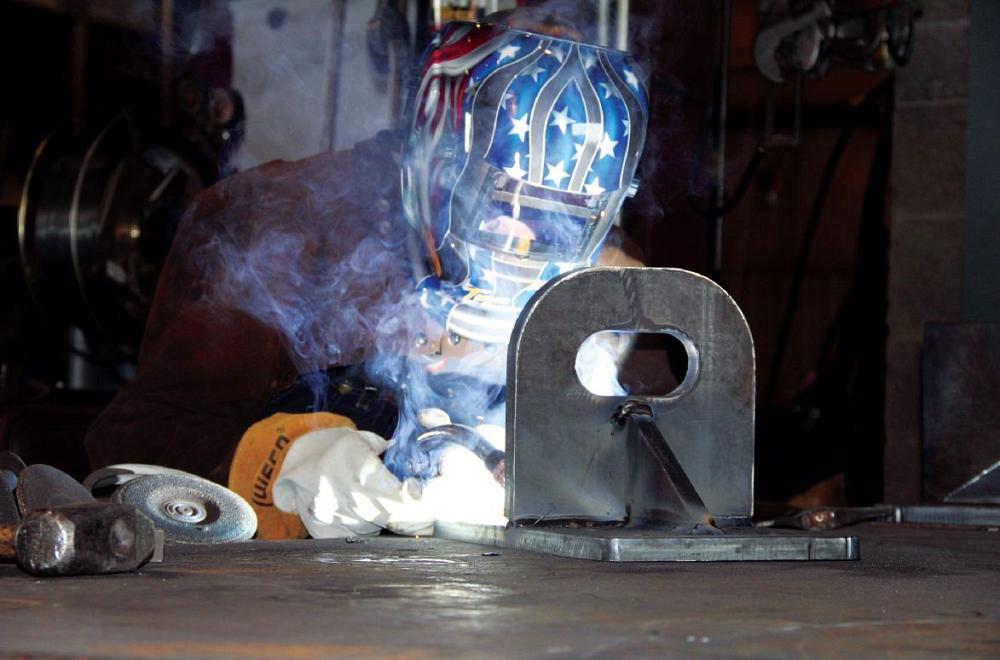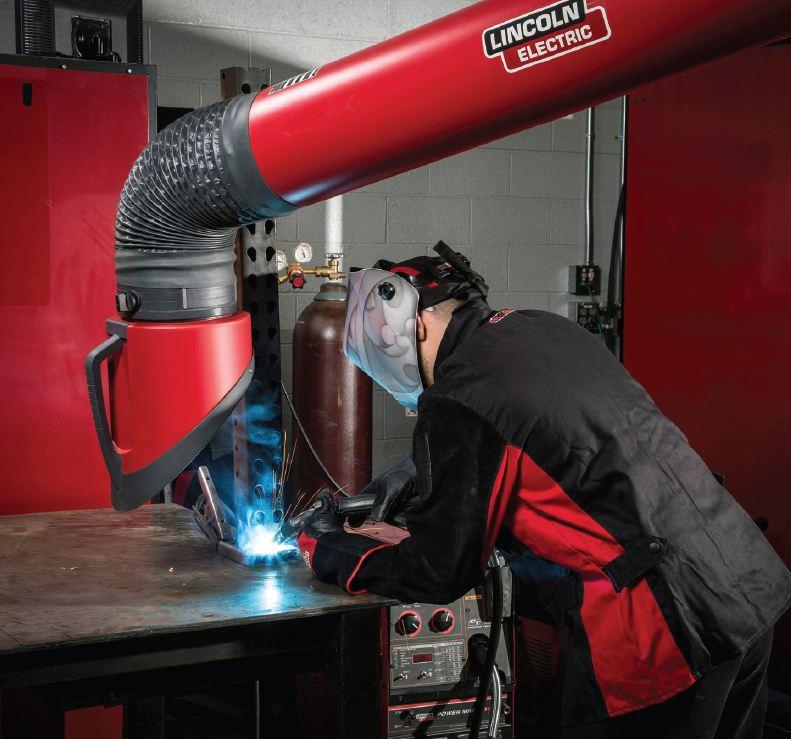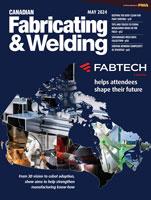- FMA
- The Fabricator
- FABTECH
- Canadian Metalworking
Clearing the air
Air quality concerns for welders, manufacturers, and regulators.
- By Nestor Gula
- February 11, 2015
- Article
- Welding
The days of grimy smoke-filled manufacturing plants are long gone. There is an ongoing push to make the work place healthier, and to this end there are more regulations coming that will mandate the reduction of allowable exposure to the harmful fumes that are created during the welding process.
“Hexavalent chromium [Cr(XI)] and manganese [Mn] are among these materials,” says Kevin A. Lyttle, senior development scientist at Praxair, Inc. in a paper he presented at the Canadian Welding Association’s Conference in October 2013. “The recent significant lowering of suggested exposures to these materials makes it imperative that the welding community have a better understanding of what can be done to reduce the amount of these and other potentially harmful constituents found in the workplace environment. The challenges of controlling fume generation are significant, but they can be met by careful selection of consumables and welding processes, and proper use of ventilation.”
While some may bemoan the introduction of new stringent regulations covering the workplace as an unnecessary intrusion by the government into the affairs of private business, the aim is to create a healthy work environment and an even playing field for competing businesses. “Foremost is the impact on worker protection as it applies to the employer’s responsibility to create a safe working environment for employees,” says Peter Elleman, director of EHS at ESAB Welding & Cutting Products. “Employers must obtain and apply the expertise to evaluate worker exposures against the evolving regulatory and scientific exposure limits.”
Complying with any new air quality standards will bring costs to the business. For Elleman, one single assessment is not sufficient for determining air quality and fume exposure. Welding is performed in a variety of scenarios; one of the only effective and accurate ways to evaluate worker exposure is through air sampling over the course of a shift or other respective period. One important factor when measuring against new regulatory standards is using a “representative period of time that encompasses the peaks and valleys of fume generation at a particular job. This industrial hygiene assessment is not a skill set of most employers, so it adds to the cost of business when an external expert is retained for this purpose. It may be a case of proving the negative, but one must make decisions based on the data from sampling rather than trusting assumptions or inference,” says Elleman.
The health of the worker is but one of the reasons for companies to invest in a healthy work environment. “An increasing number of companies are preparing to purchase or already implementing steps, such as source capture, to create a cleaner, safer welding environment,” says Allan Hilbert, fume extraction product specialist, Miller Electric Mfg. Co. “Additionally, insurance carriers are beginning to place more requirements on companies to create a viable weld fume management program, making companies take action sooner.”
Liability, from an insurance point of view, can extend beyond just the health of the workers. Elleman explains that a second concern is the potential for product liability. “By design, welding consumables can generate hazardous decomposition products during use. Manufacturers must clearly communicate the risks and uncertainties to the product purchaser and then trust that the user will use due care with the products.”
Welding fumes rise from the weld arc and are largely caused by the melting and vaporization of the consumable electrode. The fume will contain such elements as manganese and copper, but the specific chemical compounds present in the welding fume depends on the composition of the consumable electrode alloy, the base metals being welded among other factors.
“Some specific compounds in welding fume have occupational airborne exposure limits,” says Lyttle. “While in some instances there may be an exposure limit for total welding fume, the exposure limit for a given individual compound in the fume may be many orders of magnitude lower. Therefore, certain compounds of environmental health significance can effectively drive the need to limit total welding fume exposure to very low levels. These compounds typically include forms of cadmium, chromium, cobalt, copper, manganese, and nickel.”
As more research is being done on the effects of various organic and inorganic compounds on the human body, exposure limits and exposure guidelines for welding fumes continue to be modified and manufacturers should pay attention to how these can affect the business.
“In 2006 (compliance by 2010), a change was made in the Permissible Exposure Limit (PEL) in the U.S. for hexavalent chromium,” notes Lyttle. “This material is found in varying quantities in the fume generated by stainless steel welding electrodes and wires.
This limit, set at 0.005 mg/m3 for any form of Cr(VI), proved challenging but not impossible to meet through the use of engineering controls and ventilation,” he says. “In early 2013, a new Threshold Limit Value (TLV) was published by ACGIH (American Conference of Governmental Industrial Hygienists) for exposure to manganese in both respirable and inhalable forms. This new guideline is 0.02 mg/m3—a reduction from the previous TLV by a factor of 10. While this is a guideline exposure number and does not have any regulatory impact, many in industry do seek to limit personal exposures to materials in the work environment to levels at or near recommended TLVs.”
It is important to note that the ACGIH makes recommendations as opposed to standards. “Implementing the CCOHS Hierarchy of Controls is the best step toward meeting them. This hierarchy provides feasible options for reducing worker exposure to weld fume and includes four guidelines,” says Hilbert.
There are some steps that can be taken to ensure reduction of overall exposure. Miller Electric outlines four ways: (1) elimination or substitution; (2) engineering controls; administrative controls; personal protective equipment (PPE).
“Elimination or substitution uses low-manganese filler metals or changing the shielding gas to an argon mix to reduce overall fume generation rates. Engineering controls adds portable source fume extraction equipment or centralized filtration systems. Administrative Controls makes behavioral changes (e.g. proper body positioning). Personal Protective Equipment (PPE) includes respiratory protection such as half masks, powered air purifying respirators or supplied air respirators.” There are many ways that a manufacturer can comply with these new regulations and guidelines. For some, it may require a change in process, consumables or fume capture at source or a combination of any of these three methods.
“I believe that our industry is doing its best to comply with these new regulations,” says Dan Tadic, executive director of the Canadian Welding Association. “Some companies are addressing this issue with increased use of fume capture at source, use of welding respirators, change in welding consumables, or simply though a process change. An example could be the use of the Gas Metal Arc Welding (GMAW) or Submerged Arc Welding (SAW) processes.”
While shielded-metal arc (SMAW), gas-metal arc (GMAW), and flux-cored arc (FCAW) welding processes are responsible for generating a significant portion of the fume particles found in the welding environment, “gas-tungsten arc (GTAW) and submerged arc (SAW) welding processes generate significantly less fume than other techniques because of the way in which material is transferred from the consumable electrode to the weld pool. The fume generated by any of these arc welding processes depends upon a number of factors and each can have a very significant impact on fume production,” says Lyttle. Fume hoods and fume control is the primary method of dealing with this noxious smoke.
For Elleman, one of the best approaches is to direct fumes away from the welder at the source or through appropriate ventilation. “It’s also important to consider the exposures that may arise from handling the raw consumables, by-products and filters that are the less obvious exposure pathways. It’s wise to exercise good hygiene practices all around the welding activities,” he explains. Positioning and the power of the fume extraction technology are essential.
“It’s important to have a system that includes the appropriate filter to capture the fume and that provides enough velocity to pull in the weld fume before it reaches the welding operator’s breathing zone,” says Hilbert. “The combination of performance and correct filter type maintains the best capture distance. For the welder that means the hood can be further away which means less arm movements and results in more welding.”
However, a well-ventilated shop will not necessarily comply with the new guidelines alone. Tadic warns that General ventilation is not always practical as the fume may be inhaled before reaching an exhaust unit. This is why it is important to capture the fumes at the source. Whenever possible, use at-source fume control so that fugitive fumes are minimized. “At source fume extractors are also more effective tools for directing the fumes and air stream into the desired direction, away from the welder’s breathing zone,” says Elleman. “They will reduce, or possibly eliminate, the requirement to assess collateral exposures and liabilities. Whole-plant fume capture is reasonable but is not as effective as source capture. One can use both, of course.”
About the Author
subscribe now


Keep up to date with the latest news, events, and technology for all things metal from our pair of monthly magazines written specifically for Canadian manufacturers!
Start Your Free Subscription- Industry Events
Automate 2024
- May 6 - 9, 2024
- Chicago, IL
ANCA Open House
- May 7 - 8, 2024
- Wixom, MI
17th annual Joint Open House
- May 8 - 9, 2024
- Oakville and Mississauga, ON Canada
MME Saskatoon
- May 28, 2024
- Saskatoon, SK Canada
CME's Health & Safety Symposium for Manufacturers
- May 29, 2024
- Mississauga, ON Canada






















